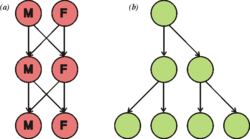Strategies

There are a wide range of reproductive strategies employed by different species. Some animals, such as the human and northern gannet, do not reach sexual maturity for many years after birth and even then produce few offspring. Others reproduce quickly; but, under normal circumstances, most offspring do not survive to adulthood. For example, a rabbit (mature after 8 months) can produce 10–30 offspring per year, and a fruit fly (mature after 10–14 days) can produce up to 900 offspring per year. These two main strategies are known as K-selection (few offspring) and r-selection (many offspring). Which strategy is favoured by evolution depends on a variety of circumstances. Animals with few offspring can devote more resources to the nurturing and protection of each individual offspring, thus reducing the need for many offspring. On the other hand, animals with many offspring may devote fewer resources to each individual offspring; for these types of animals it is common for many offspring to die soon after birth, but enough individuals typically survive to maintain the population. Some organisms such as honey bees and fruit flies retain sperm in a process called sperm storage thereby increasing the duration of their fertility.
Other types
- Polycyclic animals reproduce intermittently throughout their lives.
- Semelparous organisms reproduce only once in their lifetime, such as annual plants (including all grain crops), and certain species of salmon, spider, bamboo and century plant. Often, they die shortly after reproduction. This is often associated with r-strategists.
- Iteroparous organisms produce offspring in successive (e.g. annual or seasonal) cycles, such as perennial plants. Iteroparous animals survive over multiple seasons (or periodic condition changes). This is more associated with K-strategists.
Comments
Post a Comment